I think everyone at one point has had a hatch that was not 100% successful. And at the end of the day, with the living cheeps in the brooder, you may be left wondering... What happened to the others? What went wrong? When did my chick die? Was it there at all? There's a lot of questions and often you will hear "do an eggtopsy" or someone will say crack the duds open to find out what happened. And you should, but you should have some idea of what you're looking for as well.
So I'm going to attempt to compile a thread with images of eggtopsies myself and others have done and probable causes of death. I will add information to the first post (including pictures people add with information from posts) as we gather information. If you just want to PM pictures and information, I can repost those as well. It seems morbid at first, but I'd like to think that if you can determine what went wrong, you may be able to prevent it next time. If the learning experience can save even 1 cheep's life, then the guide is a success.
Here we go!
~~~~~~~~~~~~~~~~~~~~~~~~~~
THE PROCEDURE
Anyone can crack an egg and look at what falls out, but when there are lives on the line, it's important to be able to keep what was inside as intact as possible. You want to be gentle and observant when you do an eggtopsy, because every piece of information will help you learn what happened. You also want to avoid the mistake of bashing open an egg that may still have a live chick, on those occasions when you just aren't sure.
Before ever performing an eggtopsy, the first step is very careful candling, perhaps even at length. Of course on dark shelled eggs this is difficult, but should still be attempted. You are looking for any sign of movement that is not caused by you moving the egg, so always try to keep the egg stable while candling for this purpose. When candling, make sure that you move the light source to several different locations; note veining, dark areas where the chick is, where the air sac is located, and whether or not the shell appears porous. Here is an excellent source for pictures of 'bad' eggs: http://shilala.homestead.com/candling.html and here is this forums' own source for properly developing eggs: https://www.backyardchickens.com/forum/viewtopic.php?id=261876
If you are CERTAIN you see no movement in the egg, or the egg looks like one of the 'bad' eggs in the first link, then you get to crack it open to find out what went wrong. There are two ways to do this.
For an under-developed egg, this is fairly easy, but has the most potential for explosion, so you will want to first place the egg into a plastic baggie that can be sealed (like a ziploc). You can, of course, do this for any eggtopsy. Once it is secured, gently tap/crack in a circle around the middle of the egg until you've 'zipped' all the way around. Observe any pressure that may cause leakage when you do this; if you've cracked gently enough, nothing should be leaking out UNLESS there is pressure inside the egg, indicating bacteria. You may now pry the egg in half and take a look at what comes out. The first image on this page shows an egg cracked in half using this method.
For a developed egg (one where you are certain there is a chick, or that was close to hatching), you don't typically need to put it in a plastic baggie, but you can do so for clean up and handling sake. For these eggs, you want to be very careful, especially if you believe the chick may still be alive. You will first take a pointed but dull instrument (like a clean nail or a pencil or pen) and tap a hole at the top of the air sac (usually the large end of the egg). This will allow you to see inside the egg without breaching any important membranes. You may actually be able to see the chick moving beneath the membrane when you do this, in which case you should wrap the egg in a warm, damp cloth (do not cover the pip you've made) and place it back in the incubator. If you see no further movement from the chick, however, you can follow the cracking procedure above, making a ring around the egg and pulling the halves apart.
Here is a video example of an eggtopsy I performed: http://www.youtube.com/watch?v=MfmQGw1wtvs
~~~~~~~~~~~~~~~~~~~~~~~~~~
I'm required to state this since I'm linking to the direct images- all of these images are being stored on my Flickr account. Flickr's actually really nice for uploading pictures to share.
~~~~~~~~~~~~~~~~~~~~~~~~~~
Before I start in on the BAD deaths, here are a couple images from BeautifulPacificNorthwest of what your chick should look like if everything has gone according to plan. This particular chick died the day it should have hatched, due to a failure to pip. You can see the yolk is pulled in (yes, their bellies and lower abdomen will look distended for a bit). There's no blood or goo stuck to the chick. The feathers are wet, the feet are well formed, and the head is the right shape. The mass next to the chick is normal egg waste- the poop that didn't have anywhere else to go. The blood you see in with it is there because it was attached to the yolk- a minimal amount of blood is normal when the two separate. This gunk is OFTEN still attached to the chick when it hatches and should be cleaned off so they can dry, but don't worry if you find it in the egg shell or during an eggtopsy.

An up close of the gunk:

Here is an example of 'blood rings' from the inside of the egg. No embryo developed at all, and it ate into the yolk sack, causing a mess (which leads me to believe this blood ring was caused by bacteria). This particular one did NOT explode when cracked, but there was pressure inside of the egg. Blood rings are typical when an embryo died at a VERY early stage.

*** Edited: Bacteria can enter eggs in various ways. It could have entered inside the hen before the shell was well formed (especially if the one or both of the parents are malnourished or kept in poor living conditions where bacteria growth may be high in their environment). It can also enter through the shell if the shell has been overly cleaned (thus scrubbing away protective layers) or is too porous or is cracked in some way. Blood rings may also form from excessive heat or cold.
Here is a example of an embryo that died at a very early stage in development. I tried my best to get a candled picture, but my camera just could not perform. I took this one out for eggtopsy because the veining looked weird and the dark spot (which should be the developing chick) had a strange 'curtain' effect going on that reminded me of blood rings. I observed under candling for several minutes with no movement, and sure enough the embryo had been dead for a while. There was a bad smell when I cracked it and a slight amount of pressure. In this particular case, the egg had been sitting next to the egg pictured above, and this egg had a mottled shell under candling, making it very porous. I suspect bacteria had to do with the death. I want to say this is probably Day 10 or so?

Here are two pictures of the same chick which I believe died around Day 18-19, which is the last day I was able to observe it rocking. It never pipped at all (I checked for internal pip, but I forgot to take a picture >.< It looked as though the chick never even got to attempt pip, its head was folded under). I took a top and bottom view. Top shows the underdeveloped head, bottom shows the not-quite absorbed yolk. I *suspect* that the humidity was too much for this little guy as the rest of the hatch had some issues related to humidity.


For more humidity related death pictures, I have made a step-by-step eggtopsy post on the second page: https://www.backyardchickens.com/forum/viewtopic.php?pid=4472145#p4472145
Here is an image of a duckling which pipped around day 25 (these have a 28 day cycle instead of 21) and died. You can see the membrane is brown and gummy... I'm uncertain whether this was a result of the humidity or whether it turned this way after being dead for a few days in the incubator after pipping (I didn't turn it over to find the bottom-side pip until I took 2 others out). You can also see a huge, unabsorbed yolk... Not quite sure how that happened.

Here are two images I took late last night (or very early this morning, depending on how you want to look at it) of a duckling that had pipped on the wrong side of the egg entirely. It had made a crack just big enough to shove its bill through, then it had jammed its beak into the hole... and probably died there less than a minute later because it hadn't gotten its nostrils past the opening in the shell and it hadn't made a big enough hole to open its bill to breathe
 I would have liked to get a pic of how it was when I found it, but I panicked when I found it and started cracking away shell... but it was too late. Left side shows a (badly) candled pic of where the air cell is in relation to the beak. The second image shows the VERY sticky and gummy membrane surrounding the chick, which is either the reason it couldn't turn to pip right or something which occurred after it died and started to congeal.
I would have liked to get a pic of how it was when I found it, but I panicked when I found it and started cracking away shell... but it was too late. Left side shows a (badly) candled pic of where the air cell is in relation to the beak. The second image shows the VERY sticky and gummy membrane surrounding the chick, which is either the reason it couldn't turn to pip right or something which occurred after it died and started to congeal.


Here is an image of an egg I cracked open today, along with 3 others. The 3 were dead for reasons I can't explain and probably involve bad luck- they had just failed to pip internally and died. This one though... well, as you can see it's disgusting. I also uploaded a video I took while peeling away more of the shell to try and get a grasp on what happened. To be honest, the best I can figure is that this egg just started growing meat everywhere in any which way until it died.

Here are two images provided by user ISSOLA, of two DIFFERENT chicks. ISSOLA performed them inside plastic bags, which is why they look glassy. The chicks are clearly underdeveloped, and are sporting fully external yolks. I'm going to say they definitely died before lockdown.


Here is another image provided by user ISSOLA, of an egg she cracked at Day 11. Note the feather development along the back and the size of the eyes compared to the skull. There's also veining around the yolk, and you can see the relative size of the embryo vs. the yolk and other liquids.

Here is an image provided by user Cattitude, of a day 5 egg she broke open. Note the mess of veins that would be attached to the shell and the very tiny dot of embryo. Cattitude said a heart-beat was also visible.

Here is an image provided by user Winsor Woods, of a pigeon chick that has been shrink wrapped in the egg after pipping. Shrink wrapping typically occurs when there is a drop in humidity and temp. This can occur when you open the incubator during lockdown, or if the humidity is not enough despite the closed lid, or the airflow is too much. This egg's whole story is on Page 2 of this thread.

Here is an image provided by user Cetawin, of a chick with its intestines on the outside. This can be caused by improper development, genetics, or undue straining by the chick (in the event that the shell or membranes are too thick or the chick is too large and cannot get to the right position so pushing works). The dark brown, gummy inner membrane also indicates a problem with humidity. The discussion on this (and the two following pictures) can be found here: https://www.backyardchickens.com/forum/viewtopic.php?id=241169&p=1

Here is another image provided by user Sarochka, of the same problem. You can very clearly see the dark internal organs on the outside.

Here are two more images provided by Cetawin, of two eggs from the same hatch (and the same hatch as the above picture). Neither had pipped internally. The thread discusses possible causes which center around shipping causing weakened inner membranes, allowing the chick to expand to a size which makes it difficult to turn and pip correctly. This is not a definite answer. Both chicks looked as if they had the correct position to pip (head ducked under the wing, toward the top of the egg/air cell) but for some reason failed to do so. The second image, to me, has the color and looks to be the consistency I have found in my own chicks when the humidity was too high but it could have changed this color if the chick has been dead for more than a couple days (the blood can become old and turn brown inside the membrane and as the membrane begins to break down, the vessels can sometimes rupture, leaving the entire membrane looking brownish).


Here is an image provided by user SweetMotherOfMars, of a chick that pipped through a vein before it was ready to cope with that blood loss. More pictures of this death can be found here: https://www.backyardchickens.com/forum/viewtopic.php?pid=4484273#p4484273

Here is another image provided by user SweetMotherOfMars, of a chick which pipped internally but not externally. It still has a large external yolk, which tells it probably died shortly after pipping as they start to absorb more and more as time passes after pipping. There is liquid but it is not slimy and it is clear, not brown or yellow, meaning this was probably just a case of darn bad luck.

Here are two more images provided by SweetMotherOfMars, of a chick who pipped too low to reach the air cell and probably died to drowning in the egg. I'm posting these two to show the inner membrane (stretched out behind the chick in the first pic) and some of what is probably 'normal' white gunk on a chick. Sweet theorized that it was harmful bacteria, but as there was no bad smell, this is unlikely. It is more likely to be the outer casing of the egg white, portions of the degraded spirals which hold the yolk suspended (called a chalaza), or may even be early excrement from the chick (as it has nowhere to go and the nutrition must be processed somehow!)


Here is an image provided by user Sarochka, of a chick whose beak is tucked between its thighs instead of under its wing like it should be in order to pip. More pictures can be found here: https://www.backyardchickens.com/forum/viewtopic.php?pid=4490024#p4490024

Here is an image provided by user Sarochka, of a chick who looks to have died sometime between day 16 and 18. The yolk is still very large (almost the half the size of the chick). Sarochka says that initial inspection looked as if the yolk was ruptured, but the skin of the yolk appears unbroken. By the lumpy shape of the yolk and the other picture provided, the yolk may have been positioned strangely, or else this might be one of those 'it just died' cases.

Here is an image provided by user NaomiSarah, of a robin chick who probably died about halfway through incubation (I believe she said they have a 16 day incubation, which means this is Day 8 for the robin, but would be more like Day 10 for chickens). As this is a wild bird, there is no development of feathers, like there would be in a chicken. The details of this guy's story can be found here: https://www.backyardchickens.com/forum/viewtopic.php?id=369763

~~~~~~~~~~~~~~~~~~~~~~~
There's a sticky thread at the index page which contains this link, but I'm reposting it here for reference. This link will show you the difference between a FERTILE egg and an INFERTILE egg. If you gently crack open 'clear' eggs (no bacteria, no embryo) for eggtopsy, this link will help you determine if the egg was fertile and just didn't develop or if it never had a chance.
https://www.backyardchickens.com/forum/viewtopic.php?id=16008
**** When you buy hatching eggs, after the hatch you should crack open the clears and take note of how many were fertile/infertile. I see a lot of feedback on eBay saying that X number of eggs were not fertile when I doubt they actually CHECKED that claim. Assuming it's infertile because it did not develop isn't fair, imo. Shipping can damage perfectly fertile eggs and is out of the breeder's hands.
~~~~~~~~~~~~~~~~~
Again, if you have pictures you'd like me to post or that you'd like to add, please do! The more information we have the better.
Hope this helps, I will of course add to this first post if I do any more eggtopsies with my next hatches.
So I'm going to attempt to compile a thread with images of eggtopsies myself and others have done and probable causes of death. I will add information to the first post (including pictures people add with information from posts) as we gather information. If you just want to PM pictures and information, I can repost those as well. It seems morbid at first, but I'd like to think that if you can determine what went wrong, you may be able to prevent it next time. If the learning experience can save even 1 cheep's life, then the guide is a success.
Here we go!
~~~~~~~~~~~~~~~~~~~~~~~~~~
THE PROCEDURE
Anyone can crack an egg and look at what falls out, but when there are lives on the line, it's important to be able to keep what was inside as intact as possible. You want to be gentle and observant when you do an eggtopsy, because every piece of information will help you learn what happened. You also want to avoid the mistake of bashing open an egg that may still have a live chick, on those occasions when you just aren't sure.
Before ever performing an eggtopsy, the first step is very careful candling, perhaps even at length. Of course on dark shelled eggs this is difficult, but should still be attempted. You are looking for any sign of movement that is not caused by you moving the egg, so always try to keep the egg stable while candling for this purpose. When candling, make sure that you move the light source to several different locations; note veining, dark areas where the chick is, where the air sac is located, and whether or not the shell appears porous. Here is an excellent source for pictures of 'bad' eggs: http://shilala.homestead.com/candling.html and here is this forums' own source for properly developing eggs: https://www.backyardchickens.com/forum/viewtopic.php?id=261876
If you are CERTAIN you see no movement in the egg, or the egg looks like one of the 'bad' eggs in the first link, then you get to crack it open to find out what went wrong. There are two ways to do this.
For an under-developed egg, this is fairly easy, but has the most potential for explosion, so you will want to first place the egg into a plastic baggie that can be sealed (like a ziploc). You can, of course, do this for any eggtopsy. Once it is secured, gently tap/crack in a circle around the middle of the egg until you've 'zipped' all the way around. Observe any pressure that may cause leakage when you do this; if you've cracked gently enough, nothing should be leaking out UNLESS there is pressure inside the egg, indicating bacteria. You may now pry the egg in half and take a look at what comes out. The first image on this page shows an egg cracked in half using this method.
For a developed egg (one where you are certain there is a chick, or that was close to hatching), you don't typically need to put it in a plastic baggie, but you can do so for clean up and handling sake. For these eggs, you want to be very careful, especially if you believe the chick may still be alive. You will first take a pointed but dull instrument (like a clean nail or a pencil or pen) and tap a hole at the top of the air sac (usually the large end of the egg). This will allow you to see inside the egg without breaching any important membranes. You may actually be able to see the chick moving beneath the membrane when you do this, in which case you should wrap the egg in a warm, damp cloth (do not cover the pip you've made) and place it back in the incubator. If you see no further movement from the chick, however, you can follow the cracking procedure above, making a ring around the egg and pulling the halves apart.
Here is a video example of an eggtopsy I performed: http://www.youtube.com/watch?v=MfmQGw1wtvs
~~~~~~~~~~~~~~~~~~~~~~~~~~
I'm required to state this since I'm linking to the direct images- all of these images are being stored on my Flickr account. Flickr's actually really nice for uploading pictures to share.
~~~~~~~~~~~~~~~~~~~~~~~~~~
Before I start in on the BAD deaths, here are a couple images from BeautifulPacificNorthwest of what your chick should look like if everything has gone according to plan. This particular chick died the day it should have hatched, due to a failure to pip. You can see the yolk is pulled in (yes, their bellies and lower abdomen will look distended for a bit). There's no blood or goo stuck to the chick. The feathers are wet, the feet are well formed, and the head is the right shape. The mass next to the chick is normal egg waste- the poop that didn't have anywhere else to go. The blood you see in with it is there because it was attached to the yolk- a minimal amount of blood is normal when the two separate. This gunk is OFTEN still attached to the chick when it hatches and should be cleaned off so they can dry, but don't worry if you find it in the egg shell or during an eggtopsy.

An up close of the gunk:
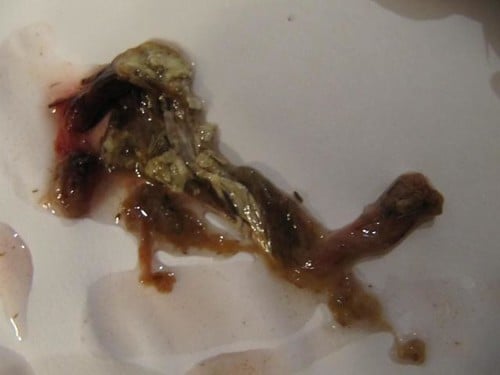
Here is an example of 'blood rings' from the inside of the egg. No embryo developed at all, and it ate into the yolk sack, causing a mess (which leads me to believe this blood ring was caused by bacteria). This particular one did NOT explode when cracked, but there was pressure inside of the egg. Blood rings are typical when an embryo died at a VERY early stage.
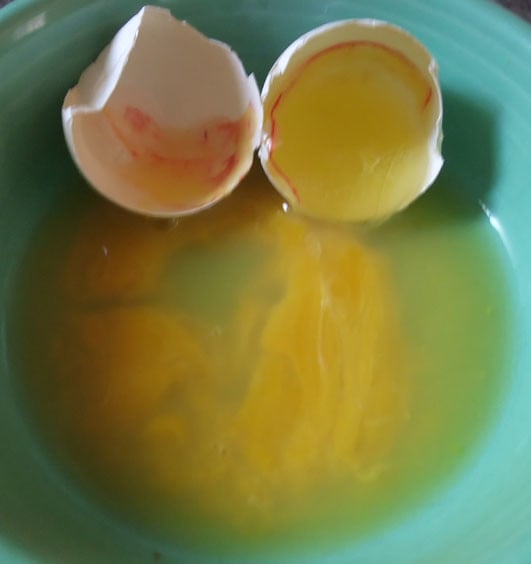
*** Edited: Bacteria can enter eggs in various ways. It could have entered inside the hen before the shell was well formed (especially if the one or both of the parents are malnourished or kept in poor living conditions where bacteria growth may be high in their environment). It can also enter through the shell if the shell has been overly cleaned (thus scrubbing away protective layers) or is too porous or is cracked in some way. Blood rings may also form from excessive heat or cold.
Here is a example of an embryo that died at a very early stage in development. I tried my best to get a candled picture, but my camera just could not perform. I took this one out for eggtopsy because the veining looked weird and the dark spot (which should be the developing chick) had a strange 'curtain' effect going on that reminded me of blood rings. I observed under candling for several minutes with no movement, and sure enough the embryo had been dead for a while. There was a bad smell when I cracked it and a slight amount of pressure. In this particular case, the egg had been sitting next to the egg pictured above, and this egg had a mottled shell under candling, making it very porous. I suspect bacteria had to do with the death. I want to say this is probably Day 10 or so?
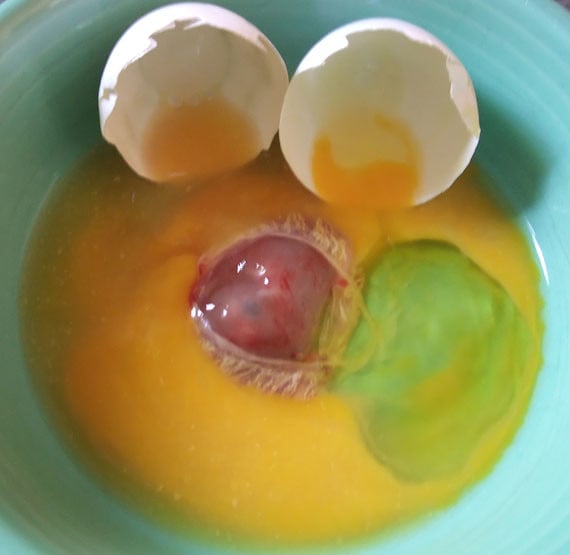
Here are two pictures of the same chick which I believe died around Day 18-19, which is the last day I was able to observe it rocking. It never pipped at all (I checked for internal pip, but I forgot to take a picture >.< It looked as though the chick never even got to attempt pip, its head was folded under). I took a top and bottom view. Top shows the underdeveloped head, bottom shows the not-quite absorbed yolk. I *suspect* that the humidity was too much for this little guy as the rest of the hatch had some issues related to humidity.
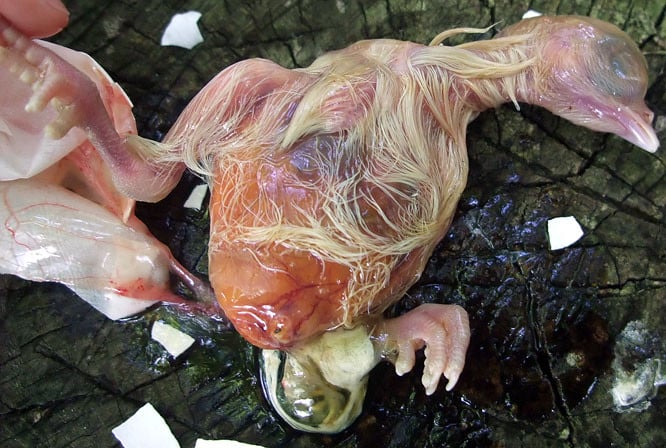
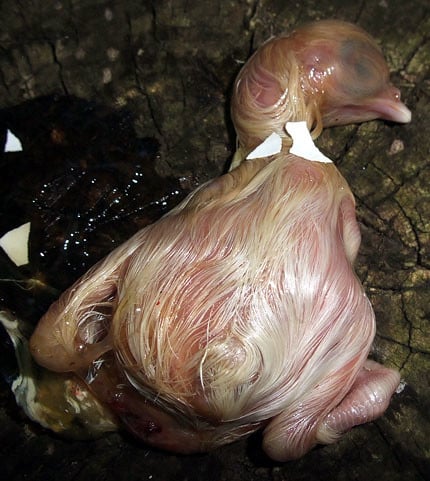
For more humidity related death pictures, I have made a step-by-step eggtopsy post on the second page: https://www.backyardchickens.com/forum/viewtopic.php?pid=4472145#p4472145
Here is an image of a duckling which pipped around day 25 (these have a 28 day cycle instead of 21) and died. You can see the membrane is brown and gummy... I'm uncertain whether this was a result of the humidity or whether it turned this way after being dead for a few days in the incubator after pipping (I didn't turn it over to find the bottom-side pip until I took 2 others out). You can also see a huge, unabsorbed yolk... Not quite sure how that happened.
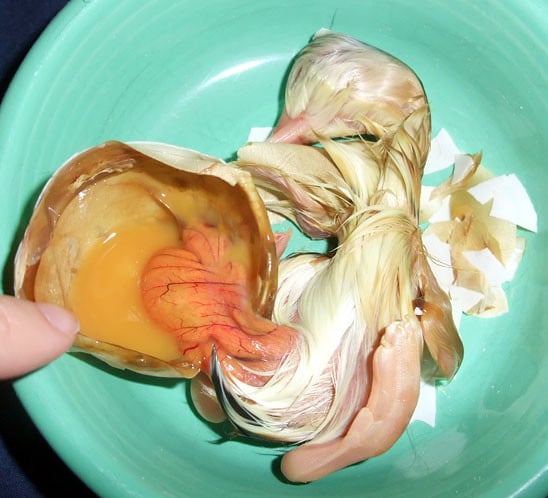
Here are two images I took late last night (or very early this morning, depending on how you want to look at it) of a duckling that had pipped on the wrong side of the egg entirely. It had made a crack just big enough to shove its bill through, then it had jammed its beak into the hole... and probably died there less than a minute later because it hadn't gotten its nostrils past the opening in the shell and it hadn't made a big enough hole to open its bill to breathe

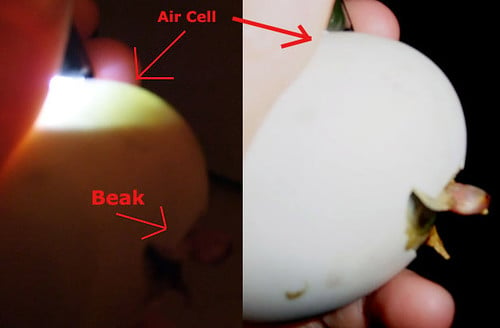
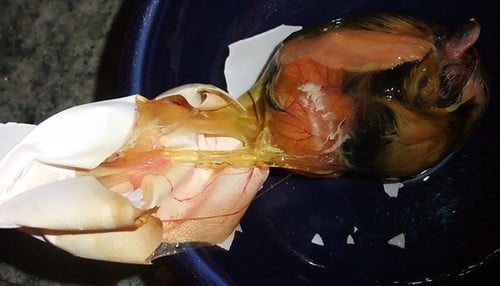
Here is an image of an egg I cracked open today, along with 3 others. The 3 were dead for reasons I can't explain and probably involve bad luck- they had just failed to pip internally and died. This one though... well, as you can see it's disgusting. I also uploaded a video I took while peeling away more of the shell to try and get a grasp on what happened. To be honest, the best I can figure is that this egg just started growing meat everywhere in any which way until it died.
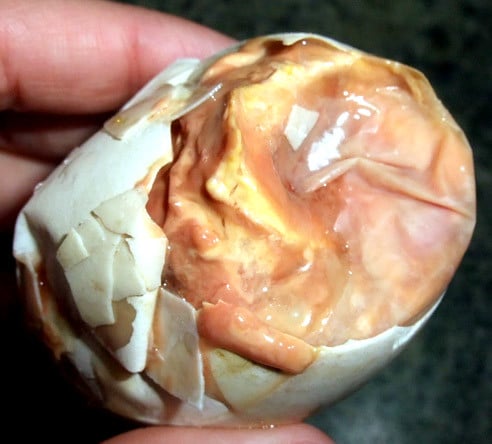
Here are two images provided by user ISSOLA, of two DIFFERENT chicks. ISSOLA performed them inside plastic bags, which is why they look glassy. The chicks are clearly underdeveloped, and are sporting fully external yolks. I'm going to say they definitely died before lockdown.
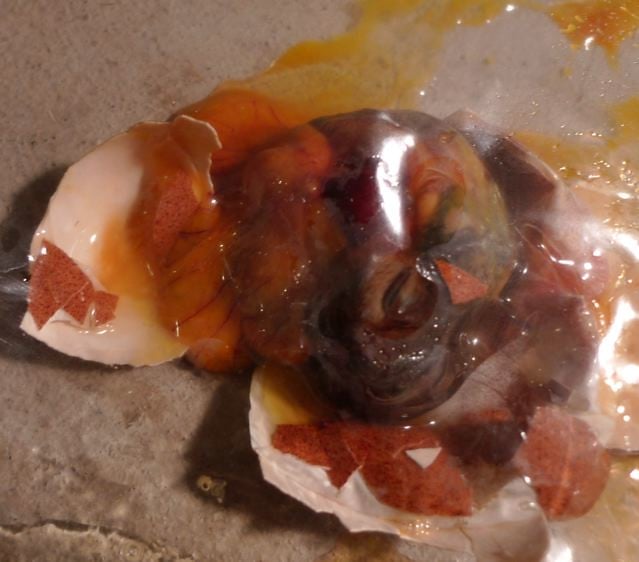
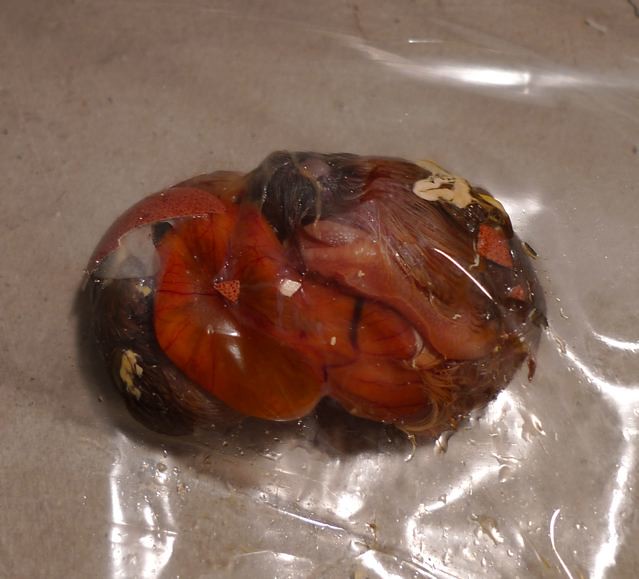
Here is another image provided by user ISSOLA, of an egg she cracked at Day 11. Note the feather development along the back and the size of the eyes compared to the skull. There's also veining around the yolk, and you can see the relative size of the embryo vs. the yolk and other liquids.
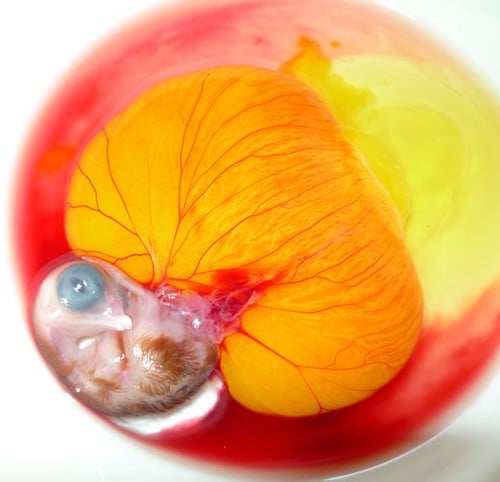
Here is an image provided by user Cattitude, of a day 5 egg she broke open. Note the mess of veins that would be attached to the shell and the very tiny dot of embryo. Cattitude said a heart-beat was also visible.
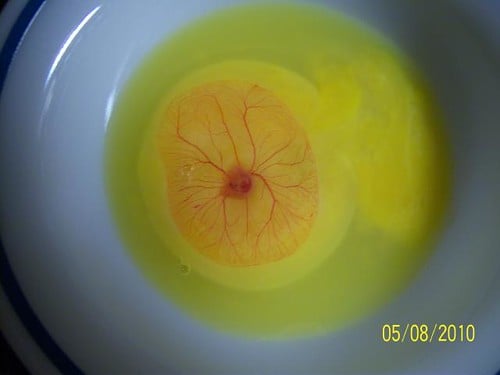
Here is an image provided by user Winsor Woods, of a pigeon chick that has been shrink wrapped in the egg after pipping. Shrink wrapping typically occurs when there is a drop in humidity and temp. This can occur when you open the incubator during lockdown, or if the humidity is not enough despite the closed lid, or the airflow is too much. This egg's whole story is on Page 2 of this thread.
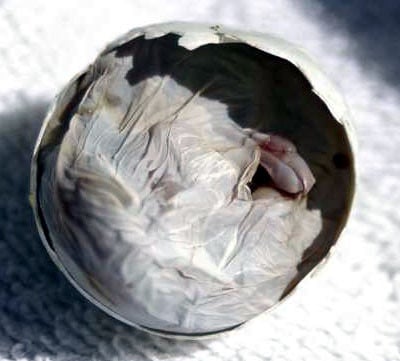
Here is an image provided by user Cetawin, of a chick with its intestines on the outside. This can be caused by improper development, genetics, or undue straining by the chick (in the event that the shell or membranes are too thick or the chick is too large and cannot get to the right position so pushing works). The dark brown, gummy inner membrane also indicates a problem with humidity. The discussion on this (and the two following pictures) can be found here: https://www.backyardchickens.com/forum/viewtopic.php?id=241169&p=1
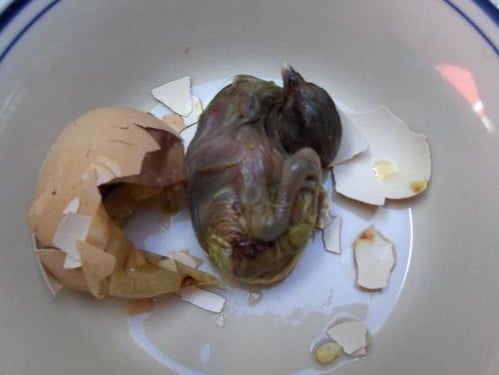
Here is another image provided by user Sarochka, of the same problem. You can very clearly see the dark internal organs on the outside.
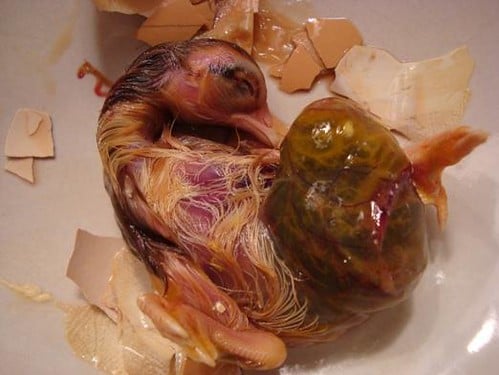
Here are two more images provided by Cetawin, of two eggs from the same hatch (and the same hatch as the above picture). Neither had pipped internally. The thread discusses possible causes which center around shipping causing weakened inner membranes, allowing the chick to expand to a size which makes it difficult to turn and pip correctly. This is not a definite answer. Both chicks looked as if they had the correct position to pip (head ducked under the wing, toward the top of the egg/air cell) but for some reason failed to do so. The second image, to me, has the color and looks to be the consistency I have found in my own chicks when the humidity was too high but it could have changed this color if the chick has been dead for more than a couple days (the blood can become old and turn brown inside the membrane and as the membrane begins to break down, the vessels can sometimes rupture, leaving the entire membrane looking brownish).
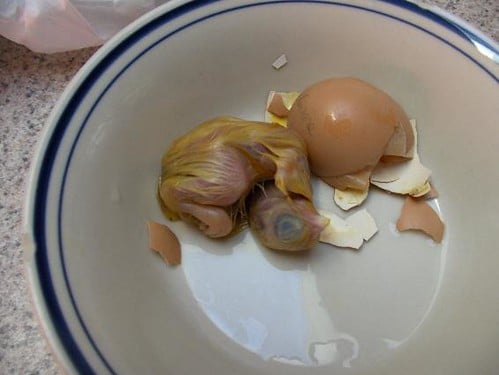
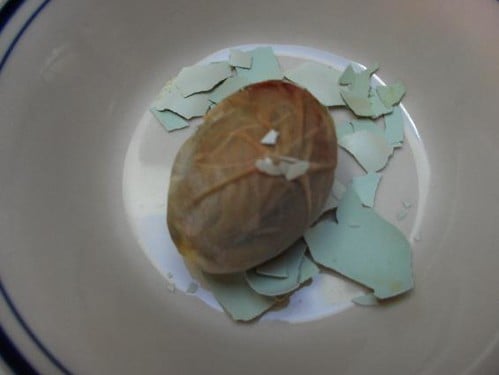
Here is an image provided by user SweetMotherOfMars, of a chick that pipped through a vein before it was ready to cope with that blood loss. More pictures of this death can be found here: https://www.backyardchickens.com/forum/viewtopic.php?pid=4484273#p4484273
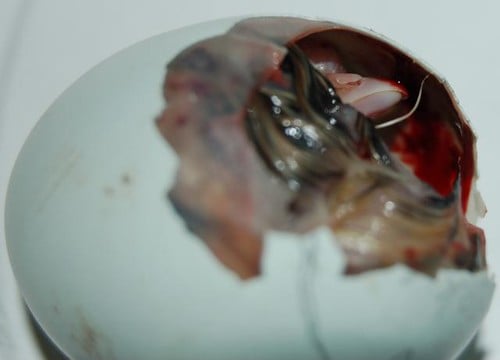
Here is another image provided by user SweetMotherOfMars, of a chick which pipped internally but not externally. It still has a large external yolk, which tells it probably died shortly after pipping as they start to absorb more and more as time passes after pipping. There is liquid but it is not slimy and it is clear, not brown or yellow, meaning this was probably just a case of darn bad luck.
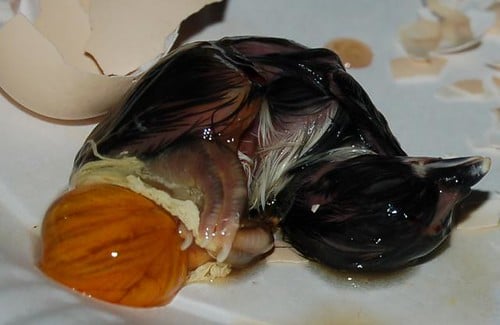
Here are two more images provided by SweetMotherOfMars, of a chick who pipped too low to reach the air cell and probably died to drowning in the egg. I'm posting these two to show the inner membrane (stretched out behind the chick in the first pic) and some of what is probably 'normal' white gunk on a chick. Sweet theorized that it was harmful bacteria, but as there was no bad smell, this is unlikely. It is more likely to be the outer casing of the egg white, portions of the degraded spirals which hold the yolk suspended (called a chalaza), or may even be early excrement from the chick (as it has nowhere to go and the nutrition must be processed somehow!)
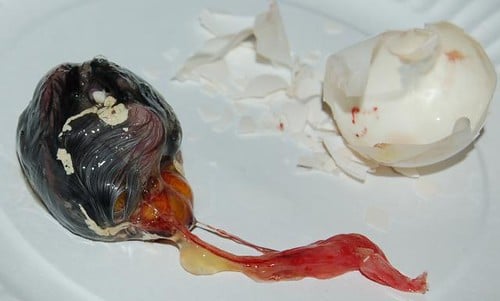
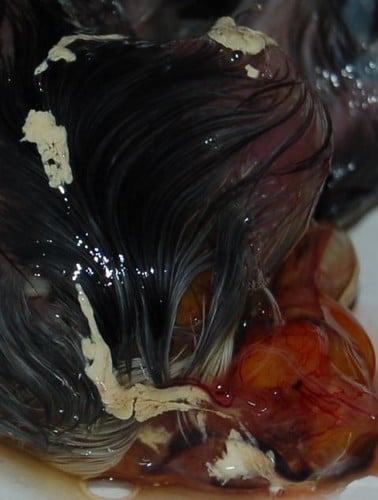
Here is an image provided by user Sarochka, of a chick whose beak is tucked between its thighs instead of under its wing like it should be in order to pip. More pictures can be found here: https://www.backyardchickens.com/forum/viewtopic.php?pid=4490024#p4490024
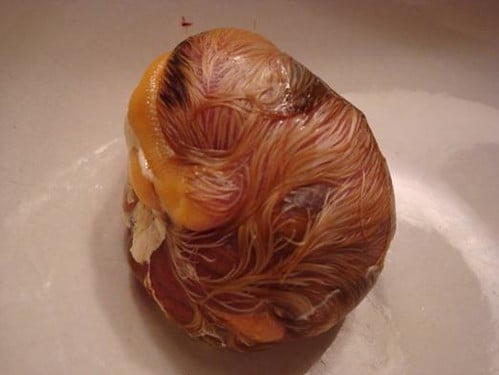
Here is an image provided by user Sarochka, of a chick who looks to have died sometime between day 16 and 18. The yolk is still very large (almost the half the size of the chick). Sarochka says that initial inspection looked as if the yolk was ruptured, but the skin of the yolk appears unbroken. By the lumpy shape of the yolk and the other picture provided, the yolk may have been positioned strangely, or else this might be one of those 'it just died' cases.
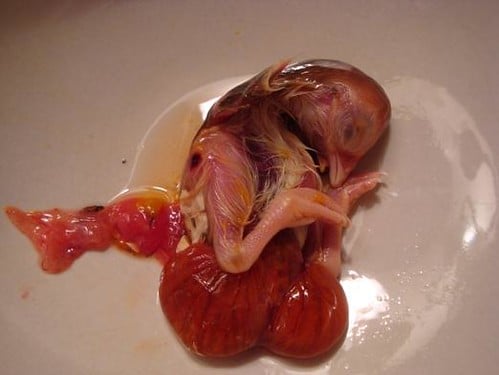
Here is an image provided by user NaomiSarah, of a robin chick who probably died about halfway through incubation (I believe she said they have a 16 day incubation, which means this is Day 8 for the robin, but would be more like Day 10 for chickens). As this is a wild bird, there is no development of feathers, like there would be in a chicken. The details of this guy's story can be found here: https://www.backyardchickens.com/forum/viewtopic.php?id=369763
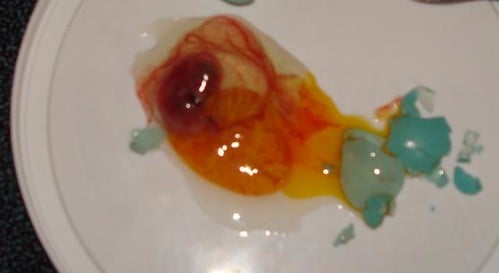
~~~~~~~~~~~~~~~~~~~~~~~
There's a sticky thread at the index page which contains this link, but I'm reposting it here for reference. This link will show you the difference between a FERTILE egg and an INFERTILE egg. If you gently crack open 'clear' eggs (no bacteria, no embryo) for eggtopsy, this link will help you determine if the egg was fertile and just didn't develop or if it never had a chance.
https://www.backyardchickens.com/forum/viewtopic.php?id=16008
**** When you buy hatching eggs, after the hatch you should crack open the clears and take note of how many were fertile/infertile. I see a lot of feedback on eBay saying that X number of eggs were not fertile when I doubt they actually CHECKED that claim. Assuming it's infertile because it did not develop isn't fair, imo. Shipping can damage perfectly fertile eggs and is out of the breeder's hands.
~~~~~~~~~~~~~~~~~
Again, if you have pictures you'd like me to post or that you'd like to add, please do! The more information we have the better.
Hope this helps, I will of course add to this first post if I do any more eggtopsies with my next hatches.
Last edited:






